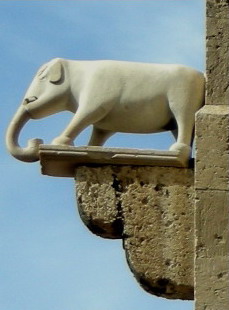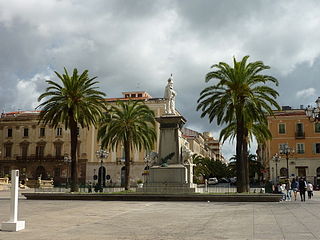


The Torre dell'Elefante (Italian: "Tower of the Elephant") is a medieval tower in Cagliari, southern Sardinia, Italy. It is located in the Castello historical quarter of the city.



The Torre dell'Elefante (Italian: "Tower of the Elephant") is a medieval tower in Cagliari, southern Sardinia, Italy. It is located in the Castello historical quarter of the city.
The tower was built in 1307, during the Pisan domination of the city, by the Sardinian architect Giovanni Capula, [1] who had also designed the Torre di San Pancrazio two years earlier, as well as the Torre dell'Aquila, partly destroyed in the 18th century and now incorporated in Palazzo Boyl. The tower was part of the city's fortifications in view of the imminent Aragonese invasion of the island, but was damaged in 1708 by English bombing, in 1717 by Spanish cannons, and finally lost its top part in 1793 during a French attack.
In 1328, the north side of the tower was closed to create residences and storage. During the Spanish age, the building was also used as a prison, and its doors would show the severed heads of the prisoners who had undergone the death penalty in the nearby plazuela (the current Piazza Carlo Alberto). As part of this phenomenon, in the second half of the 17th century, the head of Marquis Cea was hung for several years, as he had been involved in the homicide of the vice-king Camarassa.
In 1906, under the works of engineer Dionigi Scano, there was a restoration project with the aim of bringing the tower back to its original appearance, particularly by opening up the side which had been walled during the Aragonese period.
The tower was built on three sides in white limestone from the nearby Colle di Bonaria; another side was open, following the traditional Pisan style, and featured four floors of wooden galleries. The entrance was heavily defenced with three thick doors and two grates. For defending from above, there was a set of shelves to hold a wooden structure. The tower also has a gate, which, together with that of the Torre di San Pancrazio, is still the main entrance to the "Castello" quarter of Cagliari.
Its height reaches roughly 31 metres, [2] up to 35 counting the very top. From the side of via Cammino Nuovo, it reaches a height of 42 metres.
Coming from via Università or from Cammino Nuovo, at the base of the tower next to the door, one can observe an engraved stone stating when the tower was built and by whom. Further up, several crests from the 14th century can be noticed, including the emblem of the city, along with a shelf on the wall which presents a small sculpture of an elephant (chosen as a Pisan symbol).

Cagliari is an Italian municipality and the capital of the island of Sardinia, an autonomous region of Italy. It has about 155,000 inhabitants, while its metropolitan city has about 420,000 inhabitants. According to Eurostat, the population of the functional urban area, the commuting zone of Cagliari, rises to 476,975. Cagliari is the 26th largest city in Italy and the largest city on the island of Sardinia.

Sassari is an Italian city and the second-largest of Sardinia in terms of population with 127,525 inhabitants, and a Functional Urban Area of about 260,000 inhabitants. One of the oldest cities on the island, it contains a considerable collection of art.

Iglesias is a comune and city in the province of South Sardinia, Italy. It was co-capital of the province of Carbonia-Iglesias with Carbonia, and the province's second-largest community.

The Castello Sforzesco is a medieval fortification located in Milan, Northern Italy. It was built in the 15th century by Francesco Sforza, Duke of Milan, on the remnants of a 14th-century fortification. Later renovated and enlarged, in the 16th and 17th centuries it was one of the largest citadels in Europe. Extensively rebuilt by Luca Beltrami in 1891–1905, it now houses several of the city's museums and art collections.

An L-plan castle is a castle or tower house in the shape of an L, typically built from the 13th to the 17th century. This design is found quite frequently in Scotland, but is also seen in England, Ireland, Romania, Sardinia, and other locations. The evolution of its design was an expansion of the blockhouse or simple square tower from the Early Middle Ages. As building techniques improved, it became possible to construct a larger building footprint and a more complex shape than the simple blockhouse tower. A more compelling motivation for the L plan was the ability to defend the entrance door by providing covering fire from the adjacent walls. This stratagem was particularly driven by the advent of cannon used by attackers.

The Republic of Pisa was an independent state existing from the 11th to the 15th century and centered on the Tuscan city of Pisa. It rose to become an economic powerhouse, a commercial center whose merchants dominated Mediterranean and Italian trade for a century, before being surpassed and superseded by the Republic of Genoa.

Castel Nuovo, often called Maschio Angioino, is a medieval castle located in front of Piazza Municipio and the city hall in central Naples, Campania, Italy. Its scenic location and imposing size makes the castle, first erected in 1279, one of the main architectural landmarks of the city. It was a royal seat for kings of Naples, Aragon and Spain until 1815.

The Castello di Milazzo is a castle and citadel in Milazzo, Sicily. It is located on the summit of a hill overlooking the town, on a site first fortified in the Neolithic era. The Greeks modified it into an acropolis, and it was later enlarged into a castrum by the Romans and Byzantines. The Normans built a castle, which was further modified and enlarged during the Medieval and Early Modern periods. It is now in good condition, and open to the public.

Cagliari Cathedral is a Roman Catholic cathedral in Cagliari, Sardinia, Italy, dedicated to the Virgin Mary and to Saint Cecilia. It is the seat of the archbishop of Cagliari.

The Basilica of San Saturnino is a Palaeo-Christian church in Cagliari, southern Sardinia, Italy.

The Torre di San Pancrazio is a medieval tower in Cagliari, southern Sardinia, Italy. It is located in the Castello historical quarter of the city.
This article presents a history of Cagliari, an Italian municipality and the capital city of the island of Sardinia. The city has been continuously inhabited since at least the neo-lithic period. Due to its strategic location in the Mediterranean and natural harbor, the city was prized and highly sought after by a number of Mediterranean empires and cultures.

The Aragonese conquest of Sardinia took place between 1323 and 1326. The island of Sardinia was at the time subject to the influence of the Republic of Pisa, the Pisan della Gherardesca family, Genoa and of the Genoese families of Doria and the Malaspina; the only native political entity survived was the Judicate of Arborea, allied with the Crown of Aragon. The financial difficulties due to the wars in Sicily, the conflict with the Crown of Castile in the land of Murcia and Alicante (1296-1304) and the failed attempt to conquer Almeria (1309) explain the delay of James II of Aragon in bringing the conquest of Sardinia, enfeoffed to him by Pope Boniface VIII in 1297.

The Torre dello Sperone is a medieval tower in Cagliari, southern Sardinia, Italy. It is located in the Stampace historical quarter of the city.
The Battle of Lucocisterna was fought on the 29 February 1324, during the Aragonese conquest of Sardinia, between the army of the Crown of Aragon, in command of the Infante Alfonso IV of Aragon, son of King James II of Aragon, and the army of the Republic of Pisa led by Manfredi della Gherardesca, Count of Donoratico.

The castle of Ventimiglia is an ancient four towers castle which was built at the end of the 14th century by the Ventimiglia family on the top of Mount Bonifato near Alcamo, Sicily, southern Italy.
The following is a timeline of the history of the city of Cagliari, Sardinia, Italy.

The Sardinian Romanesque is the Romanesque architectural style that developed in Sardinia. The Romanesque architecture in Sardinia has had a remarkable development since the early origins, during the Giudicati era, and for a long period. His expressions, although autonomous, are not classifiable in a recognizable image, since in the island the Romanesque manifested itself with unusual results but in numerous forms; this is due to the establishment in Sardinia of several religious orders, coming from various Italian regions and from France. Consequently, in the architectures of that era Pisan, Lombard and Provençal influences are recognizable as well as traces of the passage of workers, coming from the Iberian Peninsula, of Islamic culture.

The Path of 100 Towers is a multi-day trekking route that begins and ends in Cagliari (Sardinia). The path is named after the 105 historical coastal towers along the route.